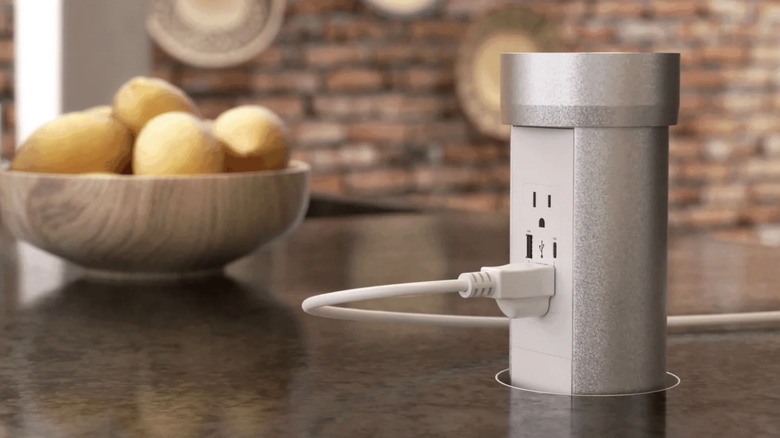Ditch The Kitchen Island Side Outlet For A Sleek, Functional Alternative Instead
Whether you finally have the chance to do a complete kitchen renovation or you are just looking for minor upgrades that can make it feel sleeker and more modern, it is important to focus on the details. Of course, you will find some stunning kitchen island trends to try, but you should also take the time to think about any frustrating aspects of the kitchen's functionality so that you can improve the utility and aesthetic simultaneously. One example of this is the outlet on your kitchen island. Outlets are often placed on the side of a kitchen island, but flat port outlets that sit flush with the countertop are easier to use and look fantastic. It is a good thing that this outlet style has so many benefits because the 2025 National Electric Code (NEC) requires receptacle outlets to be installed on or above the countertop on kitchen islands.
There are a few varieties of countertop outlets. Some of the most high-end options have flat and hidden ports, matching the countertop and sitting flush with the surface when not in use. When needed, they pop up out of the countertop, sometimes even being propelled up by motors. Alternatively, there are simple pop-up options that are more affordable and often sit just slightly above the surface of the countertop. No matter which you choose, these outlets are safe, functional, and aesthetically pleasant alternatives to an outlet on the side of your kitchen island, and they are well worth the upgrade if you have the opportunity.
The benefits of a flat countertop outlet
If your first thought about an outlet on a countertop is worrying about its safety, you are not alone. One spill seems likely to create a dangerous situation, but countertop outlets are actually required by the NEC because they are safer than outlets on the sides of islands. Outlets on the sides of islands can be tripping hazards and can be difficult to access and use. Plus, a spill on the countertop can drip down the side and damage the outlet. Countertop outlets that pop out, on the other hand, are designed to be protected from spills, unlike side outlets. There are even spill tests that outlets can pass to get an NEC certification, so you can have more peace of mind about their safety. These outlets are also required to have ground fault circuit interrupters that help protect you from dangerous shocks, just in case. Overall, while having an outlet on your countertop may seem concerning, certified outlets are a safer alternative for kitchen islands.
In addition to their improved safety, countertop outlets are functional and stylish. You can easily plug in your cooking equipment without worrying about pulling the cord too much and risking a spill. The countertop outlet can also be more accessible because it does not require you to bend down to reach the outlet. It is literally part of your workspace. Finally, the hidden port helps your kitchen look clean and streamlined.
How much do countertop outlets cost?
If you are ready to make this upgrade, then you should know more about the prices of different models and how to make the switch. For flat countertop outlets that meet all of the NEC requirements for use in a kitchen workspace, the units start at over $100. Many of these models will sit just above the countertop rather than being flush with the countertop. They may pop up or simply have a lid that flips up to give you access to the outlet. If you are willing to spend a bit more, you can find options with wireless chargers for phones on the top part of the pop-up outlet. On the more expensive side, you can get hidden receptacles that are completely flat on the countertop and have top pieces that are customized to match your countertops. These options cost over $550. If you are unsure about the steep price, finding out why you should consider hidden kitchen outlets for your next reno may be helpful.
Along with the unit itself, you may need to hire a professional to complete the installation, as the process is not always simple. The process involves drilling or cutting a hole in your countertop, installing the unit, wiring it, and sealing it. While it is possible to do on your own, to avoid the risk of damaging your countertop or having electrical issues, hiring a professional may be preferable. Learn if you can install a pop-up countertop outlet yourself or if you need a pro to decide which is best for you.


